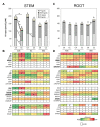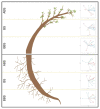Reaction Wood Anatomical Traits and Hormonal Profiles in Poplar Bent Stem and Root
- PMID: 33363556
- PMCID: PMC7754185
- DOI: 10.3389/fpls.2020.590985
Reaction Wood Anatomical Traits and Hormonal Profiles in Poplar Bent Stem and Root
Abstract
Reaction wood (RW) formation is an innate physiological response of woody plants to counteract mechanical constraints in nature, reinforce structure and redirect growth toward the vertical direction. Differences and/or similarities between stem and root response to mechanical constraints remain almost unknown especially in relation to phytohormones distribution and RW characteristics. Thus, Populus nigra stem and root subjected to static non-destructive mid-term bending treatment were analyzed. The distribution of tension and compression forces was firstly modeled along the main bent stem and root axis; then, anatomical features, chemical composition, and a complete auxin and cytokinin metabolite profiles of the stretched convex and compressed concave side of three different bent stem and root sectors were analyzed. The results showed that in bent stems RW was produced on the upper stretched convex side whereas in bent roots it was produced on the lower compressed concave side. Anatomical features and chemical analysis showed that bent stem RW was characterized by a low number of vessel, poor lignification, and high carbohydrate, and thus gelatinous layer in fiber cell wall. Conversely, in bent root, RW was characterized by high vessel number and area, without any significant variation in carbohydrate and lignin content. An antagonistic interaction of auxins and different cytokinin forms/conjugates seems to regulate critical aspects of RW formation/development in stem and root to facilitate upward/downward organ bending. The observed differences between the response stem and root to bending highlight how hormonal signaling is highly organ-dependent.
Keywords: UHPLC-MS/MS; auxins; bending stress; cytokinins; metabolite profiling.
Copyright © 2020 De Zio, Montagnoli, Karady, Terzaghi, Sferra, Antoniadi, Scippa, Ljung, Chiatante and Trupiano.
Conflict of interest statement
The authors declare that the research was conducted in the absence of any commercial or financial relationships that could be construed as a potential conflict of interest.
Figures







Similar articles
-
Poplar woody taproot under bending stress: the asymmetric response of the convex and concave sides.Ann Bot. 2016 Oct 1;118(4):865-883. doi: 10.1093/aob/mcw159. Ann Bot. 2016. PMID: 27558889 Free PMC article.
-
MicroRNAs expression patterns in the response of poplar woody root to bending stress.Planta. 2015 Jul;242(1):339-51. doi: 10.1007/s00425-015-2311-7. Epub 2015 May 12. Planta. 2015. PMID: 25963516
-
The proteome of Populus nigra woody root: response to bending.Ann Bot. 2012 Jul;110(2):415-32. doi: 10.1093/aob/mcs040. Epub 2012 Mar 20. Ann Bot. 2012. PMID: 22437664 Free PMC article.
-
Tension wood as a model for functional genomics of wood formation.New Phytol. 2004 Oct;164(1):63-72. doi: 10.1111/j.1469-8137.2004.01176.x. New Phytol. 2004. PMID: 33873474 Review.
-
The molecular basis of cytokinin function.Curr Opin Plant Biol. 2010 Feb;13(1):21-6. doi: 10.1016/j.pbi.2009.09.018. Epub 2009 Oct 21. Curr Opin Plant Biol. 2010. PMID: 19850510 Review.
Cited by
-
The Course of Mechanical Stress: Types, Perception, and Plant Response.Biology (Basel). 2023 Jan 30;12(2):217. doi: 10.3390/biology12020217. Biology (Basel). 2023. PMID: 36829495 Free PMC article. Review.
-
Meristematic Connectome: A Cellular Coordinator of Plant Responses to Environmental Signals?Cells. 2021 Sep 26;10(10):2544. doi: 10.3390/cells10102544. Cells. 2021. PMID: 34685524 Free PMC article.
-
Key Pathways and Genes of Arabidopsis thaliana and Arabidopsis halleri Roots under Cadmium Stress Responses: Differences and Similarities.Plants (Basel). 2023 Apr 27;12(9):1793. doi: 10.3390/plants12091793. Plants (Basel). 2023. PMID: 37176850 Free PMC article.
-
Overexpression of EgrIAA20 from Eucalyptus grandis, a Non-Canonical Aux/IAA Gene, Specifically Decouples Lignification of the Different Cell-Types in Arabidopsis Secondary Xylem.Int J Mol Sci. 2022 May 3;23(9):5068. doi: 10.3390/ijms23095068. Int J Mol Sci. 2022. PMID: 35563457 Free PMC article.
-
The herbaceous peony transcription factor WRKY41a promotes secondary cell wall thickening to enhance stem strength.Plant Physiol. 2023 Jan 2;191(1):428-445. doi: 10.1093/plphys/kiac507. Plant Physiol. 2023. PMID: 36305685 Free PMC article.
References
-
- Antonova G. F., Varaksina T. N., Zheleznichenko T. V., Stasova V. V. (2014). Lignin deposition during earlywood and latewood formation in scots pine stems. Wood Sci. Technol. 48, 919–936. 10.1007/s00226-014-0650-3 - DOI
-
- Begum S., Nakaba S., Bayramzadeh V., Oribee Y., Kubo T., Funada R. (2008). Temperature responses of cambial reactivation and xylem differentiation in hybrid poplar (Populus sieboldii × P. grandidentata) under natural conditions. Tree Physiol. 28, 1813–1819. 10.1093/treephys/28.12.1813, PMID: - DOI - PubMed
LinkOut - more resources
Full Text Sources

